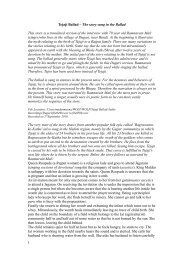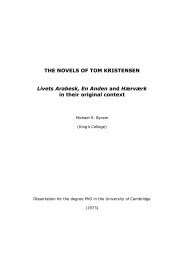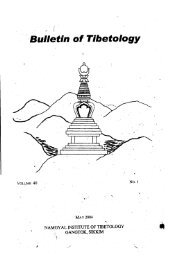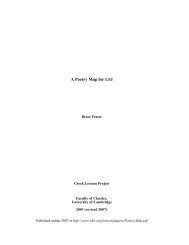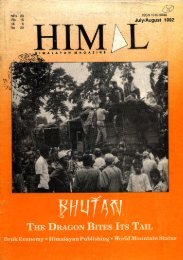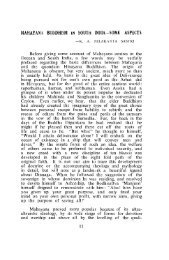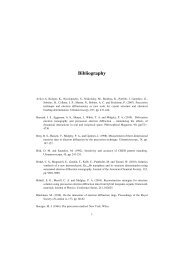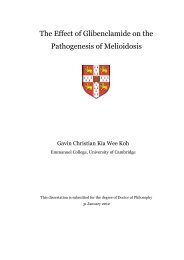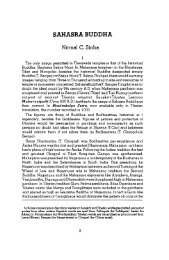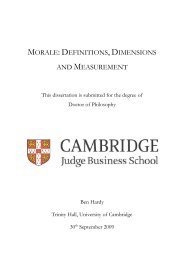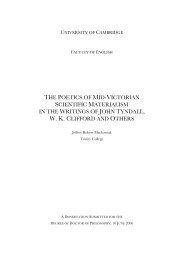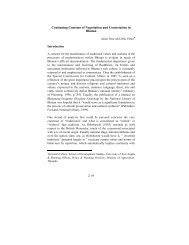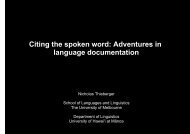The Crusades, the Genoese and the Latin East - DSpace at ...
The Crusades, the Genoese and the Latin East - DSpace at ...
The Crusades, the Genoese and the Latin East - DSpace at ...
Create successful ePaper yourself
Turn your PDF publications into a flip-book with our unique Google optimized e-Paper software.
Introduction:<br />
<strong>The</strong> merchant of Genoa is <strong>the</strong> figur<strong>at</strong>ive hero of this dissert<strong>at</strong>ion. <strong>The</strong> real heroes were many<br />
people, merchants who lived in Genoa, travellers who explored <strong>the</strong> Mediterranean Sea, men of<br />
war <strong>and</strong> peace, crusaders <strong>and</strong> also <strong>the</strong> <strong>Genoese</strong> who settled in <strong>the</strong> crusader st<strong>at</strong>es, far away from<br />
Genoa. Wh<strong>at</strong> <strong>the</strong>se people had in common, apart from being <strong>Genoese</strong>, is th<strong>at</strong> <strong>the</strong>y left records of<br />
<strong>the</strong>ir activities in <strong>the</strong> form of notarial documents. <strong>The</strong>se records were registered<br />
in large<br />
notebooks, better known as cartularies, <strong>and</strong> were l<strong>at</strong>er deposited in <strong>the</strong> archive of Genoa, where<br />
wh<strong>at</strong>ever remains is nowadays accessible. Probably this is <strong>the</strong> earliest time in <strong>the</strong> history of<br />
Europe in which such documents were not only recorded but also preserved for posterity.<br />
Coincidentally, <strong>the</strong> period in which <strong>the</strong>se documents were written was also one of <strong>the</strong> most<br />
interesting periods in <strong>the</strong> history of Europe <strong>and</strong> <strong>the</strong> Mediterranean,<br />
<strong>the</strong> time of <strong>the</strong> crusades. This<br />
means th<strong>at</strong> from <strong>the</strong> perspective of <strong>the</strong> history of <strong>the</strong> crusades, <strong>the</strong>re is a bulk of documents th<strong>at</strong><br />
have not been previously utilised. It is also exciting from <strong>the</strong> perspective of <strong>the</strong> <strong>Genoese</strong> history,<br />
because<br />
it provides a special opportunity to examine <strong>the</strong> <strong>Genoese</strong> contribution to <strong>the</strong> crusades <strong>and</strong><br />
to <strong>the</strong> crusading st<strong>at</strong>es. This was <strong>the</strong> reason for pursuing this research beginning with <strong>the</strong><br />
examin<strong>at</strong>ion of thous<strong>and</strong>s of such notarial documents, published <strong>and</strong> unpublished ones, covering<br />
a period of several decades.<br />
Historians who have examined <strong>the</strong> evolvement of Italian commerce have raised <strong>the</strong><br />
question of <strong>the</strong> impact of <strong>the</strong> crusade on <strong>the</strong> p<strong>at</strong>terns of trade. In particular, it has been asked if<br />
<strong>the</strong> found<strong>at</strong>ion of <strong>the</strong> crusader st<strong>at</strong>es cre<strong>at</strong>ed an altern<strong>at</strong>ive to trade in Alex<strong>and</strong>ria. In his article<br />
`Trade <strong>and</strong> Crusade, 1050-1250', David Abulafia reviewed <strong>the</strong> existing historiography on <strong>the</strong><br />
m<strong>at</strong>ter. Adolf Schaube's <strong>the</strong>ory was th<strong>at</strong> <strong>the</strong> crusader st<strong>at</strong>es were used as a st<strong>at</strong>ion for <strong>the</strong> Italian<br />
merchants in order to sell <strong>the</strong>ir commodities for local bezants before <strong>the</strong>y continued to Egypt to<br />
purchase goods with this money. Abulafia argued against this <strong>the</strong>ory utilising notarial evidence<br />
th<strong>at</strong> reveals th<strong>at</strong> many merchants who travelled to <strong>the</strong> <strong>L<strong>at</strong>in</strong> <strong>East</strong> did not travel to Alex<strong>and</strong>ria<br />
while many o<strong>the</strong>rs sailed directly to Alex<strong>and</strong>ria where <strong>the</strong>y sold merch<strong>and</strong>ise <strong>and</strong> bought o<strong>the</strong>r<br />
goods. ' <strong>The</strong> current study will take this issue a step fur<strong>the</strong>r by examining <strong>the</strong> ways in which three<br />
crusades affected commercial activities, trade with <strong>the</strong> <strong>L<strong>at</strong>in</strong> <strong>East</strong> <strong>and</strong> with Alex<strong>and</strong>ria, <strong>and</strong> how<br />
1 David Abulafia, `Trade <strong>and</strong> Crusade1050-1250', in Michael Goodich, Sophia Menache <strong>and</strong> Sylvia Schein<br />
(eds.<br />
), Cross Cultural Convergences<br />
in <strong>the</strong> Crusader Period (New York, 1995), pp. 14; Adolf Schaube,<br />
M<strong>and</strong>elgeschichte<br />
der romanischen Völker des Mittelmeergebiets bis zum Ende der Kreuzzüge (München,<br />
1906), pp. 152-169. Abulafia thus accepts Erik Bach's arguments about <strong>the</strong> n<strong>at</strong>ure of Italian trade in <strong>the</strong><br />
<strong>L<strong>at</strong>in</strong> <strong>East</strong>, but takes this argument fur<strong>the</strong>r. See Erik Bach, La Cite de genes au XI! siecle (Copenhagen,<br />
1955). See also Eugene H. Byrne, `Commercial Contracts of <strong>the</strong> <strong>Genoese</strong> in <strong>the</strong> Syrian Trade of <strong>the</strong><br />
Twelfth Century', <strong>The</strong> Quarterly Journal of Economics 31 (1917), p. 134, n. 1; Claude Cahen, Orient et<br />
occident au temps des croisades (Paris, 1983), p. 192.<br />
8



